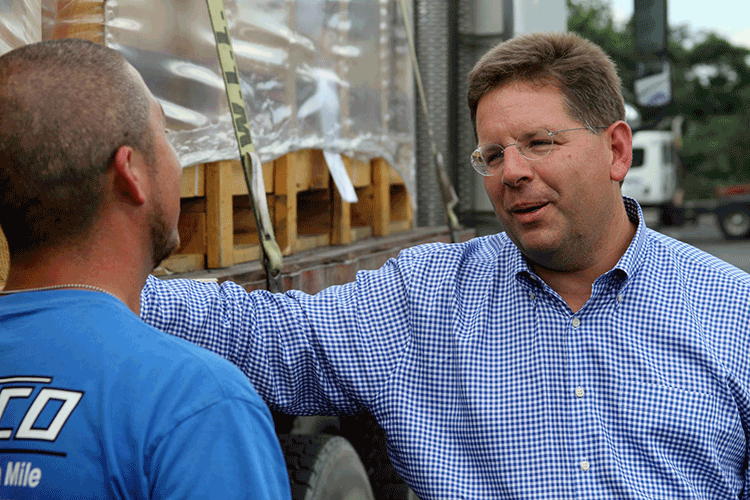The 2022 CEOs Who 'Get It'

Brian L. Fielkow
CEO
Jetco Delivery LLC
Houston, TX

Jetco Delivery is a part of Montreal-based The GTI Group, a specialized transport company that provides integrated logistics and transportation services – including asset-based trucking, freight brokerage, and warehousing and storage – to an international clientele. Founded in 1976, Jetco operates terminals in Houston, Dallas, La Porte and Freeport, TX, and serves sophisticated shippers and intermediaries to meet their logistics needs. Jetco employs 225 workers.
Describe your personal journey to becoming a CEO who “gets it.”

Early in my career, I focused on compliance, rules and regulations as the pathway to safety excellence. I had a mindset that safety was a department. In a way, that mindset was extremely parental – the safety professionals’ job was to keep everyone safe. As my thinking evolved with experience, I realized that safety is not a department. It’s a way of life.
I adopted a much more behavior-based approach to safety. Safety must be leader-driven and employee-owned. As a CEO, I know that my actions are under a microscope. If my team sees that I place other things ahead of safety, they might follow suit. You can’t lead safety with an annual obligatory safety meeting. It’s an everyday commitment.
As my career progressed, I’ve learned that safety is about each of us managing our own behavior and holding each other – and the company – accountable. When there’s a safety failure, it’s often assumed to be an individual error. However, organizational dysfunctions are at the root of many failures. I’ve become aware that the company can cause a crash, an injury or an incident as much as an individual.
I’ve also become acutely aware of what’s competing for safety. I know production pressure and meeting customer demands are critically important. But you can never allow these pressures to compromise safety. There must be nonnegotiable value alignment in the organization that nothing can compete with safety.
What is the biggest obstacle to safety at your organization, and how do you work to overcome it?
The biggest obstacle in our organization was lack of respect for process. I’d send a survey asking whether the company and our employees follow process, and I’d give people three choices for their answers: yes, no and usually. A lot of people answered “usually.” Well, “usually” is the same as saying “no.” Either you follow process, and you respect it, or you don’t. Shortcuts and workarounds are at the root of many safety failures.
We’ve overcome this in several different ways. Firstly, processes must be understandable. I look at some process manuals and just shake my head, wondering how an employee base is ever going to understand it, much less put it into action. We undertook a disciplined effort to create our process manual, The Jetco Way. We not only engaged our audience – our professional drivers – in creating it, they wrote it. Now, our process is understandable, relatable and actionable. Where possible, we support the process with photos, diagrams, charts and real-life examples.
When it comes to process, less is more. Guided by our employees, we’ve prioritized our processes to develop our life-critical rules. Life-critical rules reflect that if everything is important, nothing is important. Life-critical rules are those violations in our work environment that are more likely to have a severe outcome. A violation of one of these rules typically is a one-way ticket out of the company. In our environment, examples include driving recklessly or while using a handheld cellphone.
How do you instill a sense of safety in employees on an ongoing basis?
We’ve moved away from a “one-size-fits-all” discipline-based approach to safety failures. Adopting a just culture mentality changed the game for us. After the safety and operations teams review the situation, I want to know, was this an honest mistake, or was this deliberate, intentional behavior? A just culture leads us to train employees and look for opportunities to improve the system when someone makes an honest mistake. Most safety failures are the result of honest mistakes. We use these honest mistakes as coaching opportunities, not just for that individual, but for the entire team. We discuss with the employee their behavior, level of accountability, and willingness to learn and improve. Just culture is more focused on continuous improvement and coaching. It builds trust.
On the other hand, if we find that someone deliberately disregarded our processes, that’s probably going to shorten our relationship.
During the COVID-19 era, we have found new ways to instill a sense of safety. Just because in-person training sessions were paused does not mean training stopped. The pandemic forced different, innovative ways for our team members to learn and develop professionally. We engaged in more frequent, shorter video lessons. With everyone using games and apps on their phones or tablets, we’re adopting this way of learning and engaging by converting much of our training to gamification.
How does your organization measure safety?
I don’t want to discount traditional safety measures, such as insurance loss runs, OSHA and DOT data, but all those metrics have one thing in common: They look in the rearview mirror. They’re based on things that have already happened.
For us, truck cameras and telematics have been a game-changer to capture leading indicators. Technology has enabled us to know exactly what’s going on inside of our trucks. Our professional drivers behave admirably in extremely difficult, congested driving circumstances. We celebrate their professionalism and patience, and we’re proud of how they handle challenging situations.
However, cameras also allow us to correct behavior. Most of these behavior failures that we see are honest mistakes, so we sit down with the professional driver. We watch the video, the same way an athlete watches game tape, and we make course corrections. We learn.
Data integration is our next level for capturing leading indicators. These days, the issue is not a lack of data. It’s that we have too much data. Off the top of my head, I can think of a half dozen data sources I manage – our GPS systems; cameras; operating systems; and state, federal and insurance data. Data is not helpful if it’s not actionable. We are focused heavily on artificial intelligence and dome software that can pool all our data sources together so we can see a more holistic picture of our performance from several different angles.
Where do I see room for improvement? We continue to seek more reporting of near-miss events. If you can capture the near miss, you can prevent incidents. We are grateful for people who report near misses. This is especially true where employees need to self-report. We thank people who have the courage to come forward. It shows a maturity and willingness to help educate others so we can all learn and improve together – a true team mentality.
On this topic, I have an interesting story. I was teaching a personal development session at the NSC Safety Congress & Expo in Orlando, FL. We were talking about capturing the near miss. I admitted to the group that I would like to do better. One person raised their hand and said, “You know, we had the same problem, and we changed the name of the campaign. We went from ‘close call’ to ‘good catch,’ and that changed the psychology. The number of actionable good catches increased.” We’re now working on rebranding the campaign to see if it works for us.
What role does off-the-job safety play in your organization’s overall safety program?
Off-the-job safety is critical because our families must partner in the safety mission. I want family members to know they need to minimize contact with their loved ones when their loved ones are in the zone, performing safety-sensitive functions. Help us eliminate distractions. Help us by making sure that your loved one is rested and ready before reporting to the job.
For years, we’ve sent letters home with different safety messages. When we send letters home, we’re taking themes and making them relatable to the family. For example, if we want to talk about fall protection, it’s not going to be in an industrial setting. We’re going to discuss using a ladder, climbing on your roof, making repairs at the house. If we’re going to talk about distracted driving, we’re going to focus on your teenage children who are just learning to drive and the need to put the phone down. We’re going to make sure the discussion is emotional, that there are real life-and-death consequences. We take safety topics that are germane to our operation, and then we distill them into messages people at home can relate to.
Pre-COVID, we had annual company safety celebrations and invited the families to them. For instance, one year might be an open house and the next might be a keynote speaker. Again, always with family-focused topics. That time will come again soon.
What have you done to support employee mental health and well-being within your organization?
Over the past nearly two years of the COVID-19 pandemic, we’ve recognized that our employees and their families have faced an extraordinary amount of stress. There are more distractions than ever, from what’s happening in the news to the extra precautions families have had to take to keep themselves and each other safe.
We recognized quickly that risk tolerance regarding COVID-19 varied wildly from employee to employee. To the greatest extent possible, we allowed employees to define their work parameters. By putting employees in control of their work, we signaled understanding and trust. In return, we were rewarded with unprecedented effort, commitment and results.
Our mantra was “separated but not isolated.” Our frontline employees did not have the luxury to work remotely. With that physical separation, we understood we needed to communicate differently, compensating for the nonverbal cues you’d normally pick up while in the same meeting space and for the ability to ask questions on the spot. We increased our phone blasts, text messages, letters home, emails, signage and messaging. We developed and launched a company intranet on SharePoint to share news and other resources. We held monthly virtual town halls, video conferences we recorded so they could be played back for our employees when and where it worked for their schedules.
When dedicated employees work remotely, they tend to work flexible schedules but more hours. We’ve increased communications about protecting their mental health, including taking mental breaks while at work, doing stretches and exercises at their desks or in their cabs, taking time off, and balancing work and home. We’ve provided routine wellness education to our drivers, such as making healthy meal choices while on the road, meditation and stress management. We’ve also reminded our employees about the benefits available to them through our health insurance, including the employee assistance program.
As we’ve returned to the office, our company has reopened its onsite fitness center with additional safety measures. We’ve encouraged employees to use it not only as a place to work out, but to relax and catch up with their co-workers.
Post a comment to this article
Safety+Health welcomes comments that promote respectful dialogue. Please stay on topic. Comments that contain personal attacks, profanity or abusive language – or those aggressively promoting products or services – will be removed. We reserve the right to determine which comments violate our comment policy. (Anonymous comments are welcome; merely skip the “name” field in the comment box. An email address is required but will not be included with your comment.)


